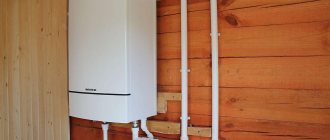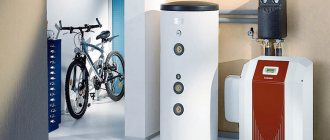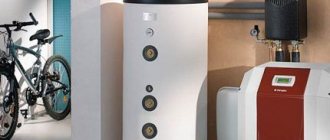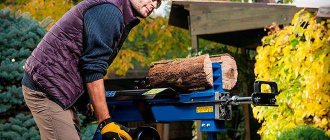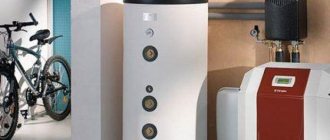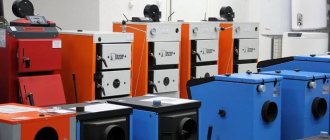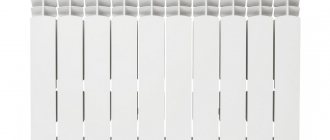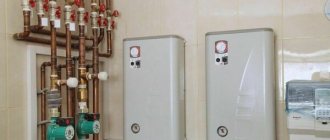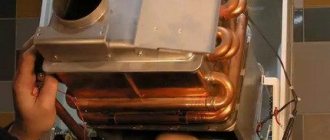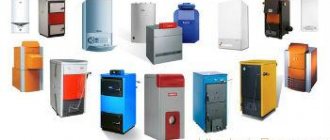Roda Brenner Classic BCR-04
- Power, kWt:
23.3 - Number of circuits:
1 - Type:
floor
Advantages:
- thermal insulation
- fuel versatility
- presence of thermometer and pressure gauge
- high efficiency
- price
Flaws:
- No
When choosing a heating boiler, the first point that the buyer pays attention to is the type of fuel used in the operation. The reason lies not only in the significant difference between the price tag, for example, for gas and electricity, but also in the availability of one or another energy carrier.
Both problems are sometimes completely, sometimes partially solved by a combined heating boiler designed to operate with several types of fuel.
Features of heating with combination boilers
The main advantage of a combi boiler lies in its name. This device can work with several types of fuel, which allows you to adjust energy costs directly during the operation of this equipment.
As an example, we can cite a situation where at some point it is much more profitable to heat a house with wood than with diesel. A similar thing can happen with electricity and liquefied gas.
Important! Combined heating boilers are mostly non-volatile, that is, they are able to continue normal operation during a power outage. Their design usually includes two combustion chambers, each of which is designed to burn a different type of fuel. Some of the models are additionally equipped with heating elements that ensure the operability of the equipment.
The obvious advantages of multi-fuel boilers include the following points:
- Independence from the availability of one energy carrier.
- Possibility of using the currently available type of fuel.
- The ability to equip several segments of the heating network, including a “warm floor”, if the boiler is equipped with several heating circuits.
- Saving costs by using the most economical fuel available at the moment.
- One combi boiler with multiple fireboxes takes up less space than multiple single-fuel units.
Some combination boilers are equipped with automatic equipment that can independently switch the equipment between types of fuel when the supply of one of them is stopped for any reason. For a private home, such a solution is extremely useful, as it relieves the owner of the need to participate in the operation of the heating system.
Naturally, like any heating boiler, multi-fuel equipment has a number of disadvantages that must be taken into account when deciding whether to install it:
- Price . It is noticeably higher compared to monofuel boilers.
- The need to organize storage areas for used solid or liquid fuels.
- The need to organize a separate boiler room . Although we can say about combination boilers that they are compact, they are still larger in size than electric or gas units. In addition, working on coal or diesel fuel is too “dirty” to place the heat generator in a separate room in the boiler room.
- The overall complexity of the design , which, in fact, has a direct impact on the cost and also complicates maintenance.
Important! Combination boilers also include models that have only one combustion chamber. To switch them to alternative fuel, the burner needs to be replaced. Considering that such devices are often also equipped with heating elements, operation on electricity is possible without replacing the burner.
Types of combination boilers for heating a private home
Among the combination boilers for heating a private home, you can choose models that meet the needs of even demanding buyers, of course, within reason.
Depending on the design features, multi-fuel heat generators are divided into several types, which allows you to choose an option for specific operating conditions without overpayment.
Single and double circuit boilers
Heating of the house can be organized by combination boilers with different numbers of circuits:
- Single-circuit boilers are designed to operate only for heating.
- Double-circuit models - with an additional circuit providing hot water supply.
Models that operate only on the heating circuit are usually more reliable due to their simplified design. Because of this they are also cheaper. On the other hand, when connecting an indirect heating boiler, heating is combined with domestic hot water. True, such a combination is more expensive than the cost of dual-circuit models.
Combination boilers with two heating circuits are equipped with either a coil or a storage tank. In the first case, DHW taps quickly heat water for domestic needs, but with limited performance, depending on power.
In the case of a storage tank, it provides domestic supply without temperature surges in the case when more than 2 to 3 consumers use hot water.
Some models, regardless of the number of circuits, are equipped with cooking tiles. To heat it up, no additional fuel is consumed, and therefore you can warm up breakfast, roughly speaking, for free.
Fuel types
A combination boiler for a home can be dual-fuel or tri-fuel. The first group includes models with the following main fuel combinations:
- Gas-solid fuel . A striking example here is an electric wood-burning boiler, since it is believed that wood itself is a cheap source of energy. However, this is true if they are mined independently. Coal and pellets can also be used as solid fuel. This design is usually poorly automated.
- Gas-electricity are relatively compact, the main fuel is cheap gas. The heating element is put into operation either to quickly heat the water, or when the main coolant is turned off. Among the advantages, variability should be noted. It is also necessary to pay attention to the fact that in most of these models, electricity is spent not on heating the coolant, but on maintaining its temperature.
- Solid fuel-electricity is popular in non-gasified regions. By design, this is a classic solid fuel boiler, but equipped with a heating element that can operate simultaneously with the firebox, or even independently, maintaining the nominal operating mode of the heat generator. Heating a house with an electric wood-burning boiler is especially beneficial in non-gasified regions with wooded areas.
Tri-fuel combined units are less popular, but among all the options you can choose quite interesting models that are easy to use:
- Gas-liquid fuel-solid fuel . The best models are not structurally complicated and have two fireboxes. The first burns either gas or liquid fuel, which depends on the installed burner (it can be changed), and the second burns only solid fuel.
- Gas-solid fuel-electricity are considered the most universal, since they use three completely different energy sources in terms of availability, reliability, and cost.
It should also be noted that combination boilers can have either separate fireboxes, each of which operates on its own heating circuit, or one common combustion chamber. True, the latter option is typical mainly for homemade heat generators and constantly receives rather contradictory reviews.
Boilers with open or closed combustion chamber
The type of combustion chamber is another criterion by which combined boilers are divided into subtypes:
- Models with an open combustion chamber . Here, combustion products are removed due to natural draft in the chimney. Air for fuel combustion is also sucked in without auxiliary devices directly from the boiler room.
- Equipment with a closed combustion chamber works exactly the opposite. Combustion products are removed forcibly, as well as air is taken in to support the combustion process. It should be noted here that the air mass is supplied from the street, that is, oxygen is not burned in the room.
The operation of a closed chamber in any case depends on the electricity that powers the fan, so in terms of autonomy it may not be the best choice.
Heating electrical installations
To work together with water heating, manufacturers produce 3 types of electric boilers:
- Heating elements. The device heats the coolant using tubular elements, which are used everywhere - in boilers, heat accumulators, heat pumps, and so on.
- Induction units heat water with a metal core placed inside an electromagnetic field.
- Electrode boilers use the conductivity of ordinary water. The current passes between two electrodes immersed in the coolant.
Mini-boiler room with tubular electric heaters placed inside a container with coolant
Heaters with heating elements externally and internally resemble mounted gas units. A circulation pump, a safety group and an expansion tank are usually hidden under the housing. Induction and electrode boilers need to be completed - buy pumps and other piping parts.
Advantages of electric water heaters:
- the best efficiency among all heat sources;
- noiselessness (excluding older models equipped with electromagnetic starters and contactors);
- low weight and size;
- low price of equipment;
- relatively simple installation;
- Full autonomy in operation, maintenance - annually at the beginning of the season.
The heating block of the electrode apparatus can be controlled remotely using room thermostats
Heat generators really do not require attention from the homeowner, except when setting the temperature. There are nuances in the operation of the electrode apparatus - the coolant must be salted, otherwise the heating intensity will decrease.
Disadvantages of electric heating boilers:
Recommendations when choosing a boiler
Studying any rating of combined boilers for a private home, you will notice that each model has its own characteristics, both in terms of operation and in physical dimensions and design. In fact, you can find units on sale that operate with four and even five types of fuel. It is the availability and cost of energy that should be considered when purchasing.
Important! Combined boilers, designed for unequal use of energy resources, when switching from the main type of fuel to a reserve one, may have a serious variation in efficiency because of this. Also, when choosing, the planned costs for the season are taken into account. When gas is available, questions usually do not arise, since it remains the cheapest. It is enough to purchase a gas-electricity model, thereby ensuring uninterrupted and efficient heating.
Based on heating season costs, the list from the cheapest energy source to the most expensive is as follows:
- Natural gas.
- Pellets.
- Firewood.
- Coal.
- Liquefied gas.
- Diesel.
- Electricity.
The placement of items in the list may vary depending on the actual cost of energy in a particular region.
Kinds
The main classification criteria are the types of fuel, as well as their quantity. According to the last sign there are:
- Bifuel boilers. They are always designed to use two types of fuel.
- Multi-fuel. They can operate on 3–4 types of fuel.
The most popular types of bi-fuel installations are:
- Universal wood-gas boilers.
- Gas-electricity units.
- Devices wood - electricity.
As for multi-fuel boilers, people most often buy wood-gas-electricity heating boilers.
The most universal multi-fuel boiler for the home is wood - gas - electricity - diesel fuel. Date: September 25, 2022
Calculation of the power of a combined boiler
In theory, for heating 10 sq.m. area requires the expenditure of 1 kW of thermal energy. However, this calculation is highly simplified and conditional, and is adjusted based on the following factors:
- The degree of insulation of the building as a whole . This takes into account not only the material of the walls, but the number of openings, what doors and windows are installed.
- Climatic features of the region . If winter is characterized by severe frosts, the difference between the ambient temperature and the mark that needs to be reached increases. This means that the equipment must be more powerful.
- Number of floors and ceiling heights . In fact, it is not the area of the house that will have to be heated, but the volume of air contained.
Thus, the power increase for a multi-circuit combination boiler can be 25 - 30%. Detailed calculations are carried out by specialists.
Is it profitable to heat a house with a combination boiler?
Variability is the main advantage of a combination boiler. With proper selection of a heat generator for specific operating conditions, heating costs are reduced. In addition, if there is a shortage of one type of fuel, you can always switch to another. It all depends on the price tag of the energy carrier and its availability.
In non-gasified coal-mining regions, it makes sense to install combined boilers in which coal is the main fuel. Usually the price tag for this energy carrier in such an area is below average. If there is access to gas, the situation simplifies even more, and solid fuel becomes a reserve fuel.
If a multi-tariff meter is installed, at night, when the cost of electricity is noticeably lower, it makes sense to use electricity to maintain the temperature in the rooms. The above options for operating a multi-fuel boiler are nothing more than examples of situational savings.
What is important to consider before installing such heating equipment?
Before installing such a heating system in your home, you should fulfill several important requirements. The boiler, as well as the entire system, must be installed:
- in a separate room;
- at a sufficient distance from the walls;
- only on a concrete foundation.
When the boiler and its elements are placed in an isolated room, this guarantees your safety. Under no circumstances should any objects, clothes, or shoes be stored in such a room. In short, there should be no flammable elements near the boiler other than fuel for equipment or boiler components.
Of course, if you are not a professional in this matter, then it is best to turn to the experts for help with installation. They will do their job efficiently and without any complaints. At the same time, if you have certain skills, you can take on this work yourself. All necessary materials and tools can be purchased at the store where the boiler was sold.
When connecting and setting up the unit, it is important to remember that good draft and high-quality ventilation are important for the full operation of the system.
Installation Requirements
Almost all combination boilers are manufactured in a floor-standing design and require a separately equipped boiler room. In addition, when installing them, it is necessary to comply with a number of fire and electrical safety requirements, as well as compliance with SNiPs. Below are the main installation features.
Room
- Availability of a reinforced individual foundation for installation of boiler equipment.
- Compliance with fire safety standards.
- Dryness in the boiler room, protection from moisture penetration.
- Non-combustible wall material.
- The minimum distance between the boiler and any wall is 300 mm.
Chimney
- Sealing of joints.
- No cracks or other mechanical damage.
- Insulation that prevents the formation of condensation and ice, which can lead to blockage of the chimney duct.
- The head is at least 500 mm high.
Circuit
Here it is important to eliminate the possibility of contact with water of any current-carrying elements, if any. Also a mandatory requirement is the correct selection of the cross-section of the supply wiring, which is calculated based on the total power of the equipment being powered and the current consumed.
The best manufacturers
Ratings of combination heating boilers can include dozens of models from a variety of manufacturers. Among them there are those that are especially popular among buyers and are rightfully considered one of the best.
Protherm
This European manufacturer of heating boilers is distinguished by a wide range of products, numbering more than 90 items, including heat generators of almost every type, including innovative condensing models. Products are supplied to more than 25 countries from Europe, Asia and Africa, where they have earned the trust of consumers.
Protherm boilers are certified according to ISO 9001, have an affordable price for a wide range of buyers and a wide range of models. In addition, the manufacturer provides professional service both through its own services and through partner companies, whose employees must undergo special training.
Roda
The products of the German manufacturer Röda are represented on the domestic market by electric, gas, solid fuel and, of course, combination boilers. Roda is European quality climate control equipment with service throughout the Russian Federation and a wide network of dealers.
Roda solid fuel boilers all have natural draft, and the combustion intensity is adjusted using a thermomechanical regulator. On the other hand, you can retrofit the heat generator with automation. It is also possible to install a control unit and a forced air intake fan.
ZOTA
The domestic manufacturer ZOTA offers customers, among other things, combined heating boilers using wood and coal with the ability to connect heating elements as an option.
They have an affordable price tag, and there are models with a hotplate. Some solid fuel heat generators fully provide long-term combustion, amounting to 8–12 hours, depending on the type of energy carrier.
Teplodar
Another domestic manufacturer that offers customers not only boilers, but also stoves and even fireplaces. Teplodar has been working in the heating industry for 20 years and has more than 50 patents for unique developments.
High-quality materials are used in production, and the reliability of the products is confirmed by various certificates. The model range includes horizontal heat generators of the “Comfort” series with a spacious firebox designed for firewood up to 50 cm long.
© 2022 All rights reserved
Review of popular models and prices
The choice of all kinds of combined devices is huge. The popularity of certain brands is due to both low cost and credibility. Domestic manufacturers confidently outperform many famous foreign brands in terms of price-quality.
KChM from OJSC Kirovsky produces its heating equipment using the method of vacuum-film molding of cast iron castings using the technology and equipment of the German company HWS. The housings of KChM universal units are completely cast iron with cooled grates and spacious combustion chambers. The plant offers this type of solid fuel equipment in a power range from 21 to 80 kW, and its main feature is the ability to convert to gas or liquid fuel.
Zota Mix
The main distinguishing feature of Zota Mix solid fuel heat generators is their efficient operation on almost any solid fuel, including brown coal. They also provide the possibility of installing a gas burner, fuel injector or heating element. This makes the Zota Mix equipment line in demand in the combined units market.
Prices for combi boilers Zota Mix
combi boilers Zota Mix
Smoke Series
The Dymok series includes five types of heat generators, well known under the Zota brand. They can be produced with or without a frying surface. All models are completely energy independent, but it is possible to separately purchase and install heating elements.
Karakan boiler series
The Karakan series of gas water heaters is a product of the domestic company STEN. The line includes devices with power from 7 to 12 kW. A key feature of the units is the possibility of retrofitting with heating elements, which will ensure the operation of the systems in the absence of gas or during maintenance work.

